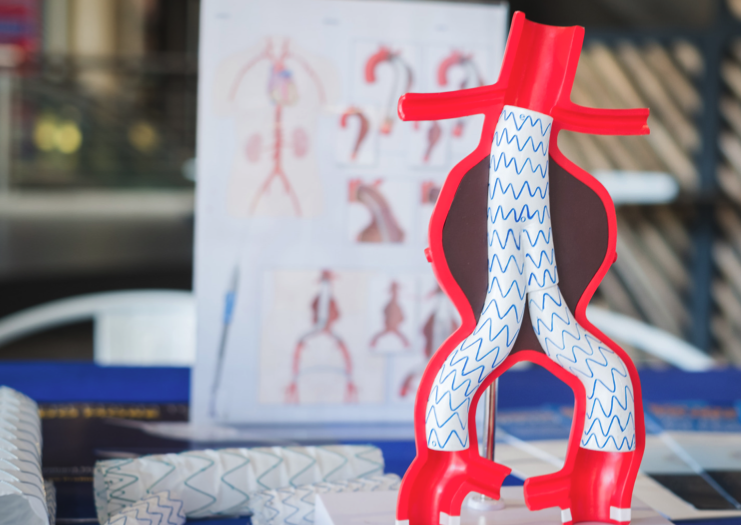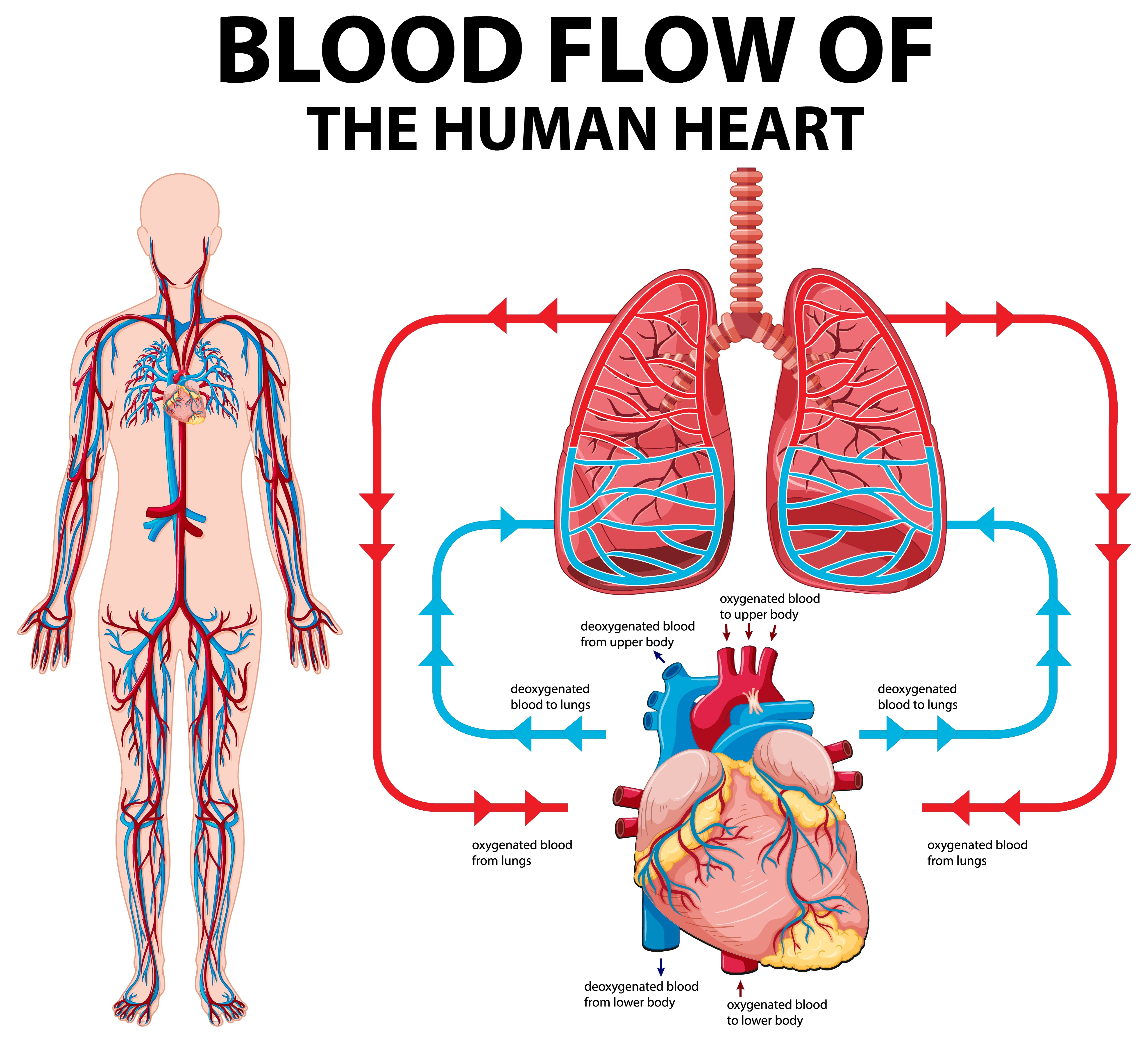Definisi
Aneurisma aorta adalah pelebaran tidak normal (aneurisma) pada salah satu segmen pembuluh darah aorta. Pelebaran pembuluh darah ini menyebabkan adanya bagian pembuluh darah yang menggembung seperti kantung atau balon. Kantung ini dapat mengganggu aliran pembuluh darah dan menyebabkan komplikasi yang berbahaya jika pecah (ruptur).
Darah di dalam tubuh mengalir di dalam pembuluh darah. Manusia memiliki tiga jenis pembuluh darah, yaitu arteri (membawa darah kaya oksigen), vena (membawa darah kaya karbon dioksida), dan kapiler (pembuluh darah yang menjembatani arteri dan vena). Aorta adalah arteri utama dan terbesar di dalam tubuh. Aorta secara langsung terhubung dengan jantung sebagai saluran pertama dari darah kaya oksigen sebelum dialirkan ke bagian tubuh yang lain.
Aorta memanjang dari rongga dada hingga setinggi ginjal. Aorta yang terdapat pada rongga dada disebut aorta torakalis, sedangkan aorta yang terdapat pada rongga abdomen disebut aorta abdominalis. Aneurisma dapat terjadi sepanjang pembuluh darah aorta ini. Berdasarkan pembagian tersebut, aneurisma aorta dibagi menjadi:
- Jika terjadi pada aorta torakalis, aneurisma disebut sebagai aneurisma aorta torakal.
- Jika terjadi pada aorta abdominalis, aneurisma tersebut disebut sebagai aneurisma aorta abdominalis (AAA).
Dua tipe aneurisma tersebut adalah tipe yang paling sering terjadi dan ditemukan, namun, aneurisma dapat terjadi pada pembuluh darah lainnya, seperti arteri poplitea (pada daerah lutut), arteri renal (ginjal), dan lain-lain.
Data CDC di Amerika menunjukkan bahwa aneurisma aorta atau diseksi aorta merupakan penyebab dari 9904 kematian pada tahun 2019. Sekitar 59% dari kasus tersebut terjadi pada laki-laki dan 75% penderita aneurisma aorta memiliki riwayat merokok. Hal tersebut menyebabkan Amerika Serikat menetapkan peraturan skrining untuk setiap laki-laki berusia 65-75 tahun dengan riwayat merokok, sekalipun tidak memiliki gejala.
Penyebab
Sebagai pembuluh darah yang paling besar dan perlu menahan tekanan yang tinggi, aorta memiliki lapisan dinding yang tebal dan kokoh. Namun, dinding tersebut dapat melemah akibat hal-hal tertentu, contohnya tekanan darah tinggi yang berlangsung lama atau kelainan genetik. Jika sebagian dinding aorta melemah, aliran darah yang bertekanan tinggi akan mendorong bagian dinding aorta yang lemah tersebut sehingga membentuk pelebaran. Jika pelebaran terjadi terus-menerus, kantung dapat terbentuk. Kondisi ini disebut sebagai aneurisma.
Hal-hal yang dapat mengganggu struktur dinding aorta antara lain:
- Kekakuan pembuluh darah (aterosklerosis). Lemak dapat menempel pada dinding pembuluh darah dan menyebabkan kekakuan pada dinding tersebut. Hal ini disebut sebagai aterosklerosis.
- Tekanan darah tinggi. Tekanan darah yang tinggi dalam jangka waktu lama dapat melemahkan dinding pembuluh darah.
- Kondisi medis tertentu seperti Sindrom Marfan, dimana terjadi gangguan jaringan ikat pada seluruh tubuh.
- Peradangan pada pembuluh darah akibat infeksi atau kondisi medis lainnya.
- Cedera pembuluh darah akibat kecelakaan.
Faktor Risiko
Faktor yang dapat meningkatkan risiko mengalami aneurisma aorta, antara lain:
- Penggunaan tembakau. Merokok merupakan faktor risiko utama dari aneurisma aorta. Merokok dapat menyebabkan kelemahan pada dinding pembuluh darah sehingga meningkatkan risiko terbentuknya aneurisma dan pecahnya aneurisma tersebut.
- Usia. Usia 65 tahun atau lebih memiliki risiko lebih tinggi untuk mengalami aneurisma aorta.
- Riwayat keluarga. Riwayat keluarga dengan aneurisma aorta meningkatkan risiko untuk mengalami aneurisma aorta di masa depan.
- Kondisi medis. Jika Anda didiagnosis mengalami Sindrom Marfan atau kondisi lainnya, Anda memiliki risiko lebih tinggi untuk mengalami aneurisma aorta torakalis.
- Riwayat tekanan darah tinggi dan kolesterol tinggi dapat mengganggu struktur dinding pembuluh darah dan meningkatkan risiko terjadinya aneurisma.
Gejala
Aneurisma aorta umumnya tidak menimbulkan gejala apapun dan timbul perlahan-lahan. Hal ini menyebabkan aneurisma aorta sulit untuk dideteksi. Beberapa aneurisma tidak pernah robek, ruptur, dan menimbulkan gejala. Namun, jika aneurisma tersebut mulai membesar, beberapa gejala dapat timbul bergantung pada lokasi aneurisma.
Gejala dari aneurisma aorta torakalis, antara lain:
- Nyeri pada dada
- Nyeri punggung
- Suara serak
- Batuk
- Sesak terus menerus
Gejala dari aneurisma aorta abdominalis (AAA), antara lain:
- Nyeri terus-menerus di daerah perut
- Nyeri punggung
- Terlihat gerakan denyut jantung yang jelas di daerah perut
Diagnosis
Untuk mendiagnosis aneurisma, dokter Anda akan melakukan pemeriksaan fisik dan pemeriksaan radiologi. Pada pemeriksaan fisik, dokter akan melakukan pemeriksaan pada daerah perut untuk mencari gerakan yang sama dengan denyut jantung, mendengarkan suara jantung Anda, memeriksa nadi pada tangan dan kaki, serta mencari gejala lain yang sesuai dengan kondisi medis lain, seperti Sindrom Marfan.
Dokter dapat melakukan pemeriksan tambahan berupa:
- Ultrasound. Ultrasound dapat membantu dokter untuk melihat aliran darah pada daerah perut untuk mendeteksi adanya AAA. Prosedur ini tidak berbahaya dan tidak nyeri.
- Echocardiogram. Echocardiogram dapat membantu dokter untuk melihat adanya aneurisma pada aorta torakalis. Prosedur ini dapat melihat struktur dan mengukur fungsi jantung serta aorta secara real-time (langsung).
- CT Scan atau MRI. CT scan atau MRI merupakan pemeriksaan radiologis yang dapat digunakan untuk melihat gambaran aneurisma lebih jelas dibandingkan ultrasound atau echo. Pemeriksaan ini berfungsi untuk panduan dokter saat melakukan tindakan pengobatan atau pemantauan kondisi aneurisma pasca pengobatan.
Tata laksana
Tujuan pengobatan aneurisma adalah untuk mencegah pelebaran aneurisma dan mengobati aneurisma tersebut sebelum ruptur (robek) atau mengalami diseksi. Bergantung pada ukuran aneurisma dan laju pembesarannya, pengobatan dapat berupa observasi/pemantauan (watchful waiting) hingga pembedahan.
- Observasi. Jika aneurisma berukuran kecil dan memiliki risiko rendah untuk pecah, dokter akan merekomendasikan pemeriksaan rutin untuk memantau kondisi aneurisma tersebut. Dokter akan meminta Anda untuk memperbaiki gaya hidup dan berhenti merokok.
- Obat-obatan. Obat-obatan tidak berperan untuk mengembalikan struktur pembuluh darah seperti semula, namun berfungsi untuk mencegah pelebaran aneurisma. Obat-obatan tersebut antara lain adalah obat-obatan pengontrol tekanan darah tinggi (beta bloker, ACE-I, dan lain-lain) serta obat pengontrol kolesterol (seperti statin). Jika dokter Anda meresepkan obat-obatan ini, konsumsi dengan teratur. Jangan beli obat tanpa berkonsultasi dengan dokter terlebih dahulu.
- Operasi. Operasi umumnya adalah langkah yang diambil untuk aneurisma yang berukuran besar, berisiko tinggi untuk pecah, dan menimbulkan gejala. Terdapat dua jenis metode operasi yang dapat dilakukan:
- Operasi endovaskular. Teknik ini dilakukan dengan memasukkan kateter ke dalam aorta. Kateter tersebut membawa metal mesh support untuk membantu menjaga kekuatan dinding aorta. Penyembuhan dengan teknik endovaskular umumnya lebih cepat dibandingkan teknik open chest surgery atau open abdominal surgery.
- Open chest dan Open abdominal surgery. Kedua teknik ini memiliki prinsip yang sama, hanya dikerjakan untuk aneurisma yang berbeda. Open chest surgery dilakukan untuk menangani aneurisma aorta torakalis, sedangkan open abdominal surgery dilakukan untuk menangani aneurisma aorta abdominalis (AAA). Dokter akan mengangkat bagian dinding pembuluh darah yang lemah dan menggantinya dengan lapisan baru (graft) yang lebih kuat. Penyembuhan dari prosedur ini membutuhkan waktu yang lebih lama.
Komplikasi
Komplikasi dari aneurisma aorta adalah:
- Aneurisma diseksi. Aneurisma diseksi merupakan kondisi robeknya dinding pembuluh darah yang mengalami pelebaran atau aneurisma. Pada diseksi, tidak seluruh lapisan pembuluh darah robek, sehingga darah mengalir dan mengisi lapisan-lapisan dinding tanpa sepenuhnya keluar dari pembuluh darah. Walau terlihat tidak berbahaya, diseksi dapat mengganggu aliran darah secara keseluruhan dan berpotensi menyebabkan syok hingga kematian.
- Ruptur aneurisma. Ruptur aneurisma adalah robeknya dinding pembuluh darah secara keseluruhan sehingga darah keluar dari pembuluh darah ke rongga tubuh lainnya. Kondisi ini sangat berbahaya dan merupakan kondisi gawat darurat.
- Gumpalan darah (blood clot). Kantung pada pembuluh darah dapat menyebabkan aliran darah terganggu dan adanya darah yang tertahan di kantung tersebut. Tertahannya aliran darah (stasis) dapat menyebabkan gumpalan-gumpalan kecil darah. Jika gumpalan kecil darah ini terlepas, sumbatan pada pembuluh darah lainnya dapat terjadi.
Pencegahan
Untuk mencegah aneurisma aorta atau mencegah perburukan lebih lanjut, Anda dapat melakukan langkah-langkah di bawah ini:
- Berhenti merokok. Hindari konsumsi tembakau dalam bentuk apapun, termasuk menjadi perokok pasif. Jika Anda memerlukan bantuan untuk berhenti merokok, konsultasikan ini dengan dokter Anda.
- Konsumsi makanan yang sehat dan seimbang. Libatkan sayur dan buah dalam diet Anda. Hindari makanan tinggi kolesterol dan lemak jenuh.
- Jaga tekanan darah dan kolesterol Anda tetap normal. Jika dokter meresepkan obat untuk mengontrol tekanan darah tinggi dan kolesterol Anda, konsumsi lah obat-obatan tersebut secara rutin walaupun tidak ada gejala apapun.
- Lakukan aktivitas fisik sebanyak 150 menit per minggu. Jika Anda tidak aktif berolahraga, Anda dapat memulai kebiasaan ini sedikit demi sedikit hingga mencapai target 150 menit.
Kapan Harus ke Dokter?
Anda perlu melakukan pemeriksaan jika Anda memiliki keluarga dengan riwayat aneurisma, berusia lebih dari 65 tahun, dan memiliki kondisi medis lain seperti Sindrom Marfan. Aneurisma umumnya tidak menimbulkan gejala hingga robek atau pecah, sehingga melakukan deteksi dini merupakan hal yang penting, terutama jika Anda memiliki faktor risiko.
Segera kunjungi IGD jika Anda mengalami gejala dari pecahnya aneurisma, antara lain:
- Nyeri tajam, mendadak, seperti robekan pada dada yang menjalar ke bagian bawah
- Nyeri yang menjalar ke dada, bahu, leher, dan lengan
- Sulit bernapas
Mau tahu informasi seputar penyakit lainnya? Cek di sini, ya!
- dr Nadia Opmalina
Beckerman J. (2021). What is an aortic aneurysm. WebMD. Available from: https://www.webmd.com/heart-disease/heart-disease-aortic-aneurysm
Centers for Disease Control and Prevention. (2021). Aortic aneurysm. Available from: https://www.cdc.gov/heartdisease/aortic_aneurysm.htm
Mayo Clinic. (2021). Aortic aneurysm. Available from: https://www.mayoclinic.org/diseases-conditions/aortic-aneurysm/symptoms-causes/syc-20369472
Mayo Clinic. (2021). Abdominal aortic aneurysm. Available from: https://www.mayoclinic.org/diseases-conditions/abdominal-aortic-aneurysm/diagnosis-treatment/drc-20350693
Mayo Clinic. (2020). Thoracic aortic aneurysm. Available from: https://www.mayoclinic.org/diseases-conditions/thoracic-aortic-aneurysm/symptoms-causes/syc-20350188
National Heart, Lung, and Blood Institute. (2022). Aortic Aneurysm. Available from: https://www.nhlbi.nih.gov/health/aortic-aneurysm












